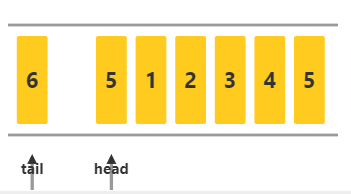基於C語言的嵌入式適用的數據結構---佇列和回圈佇列
2020-08-14 11:06:38
爲什麼要寫這篇部落格?
嵌入式開發中,在很多的環境下無法使用官方庫,可以自己寫數據結構,進行使用。
佇列特點:先進先出
- 構造
- 入隊
- 遍歷
- 出隊
- 釋放記憶體
結構體定義和初始化構造
// 請在下面 下麪實現佇列 Queue
typedef struct Queue{
// 編號
int *data;
int head, tail, length;
}Queue;
// 請在下面 下麪實現初始化函數 init
void init(Queue *q, int length){
q->data = (int*)malloc(sizeof(int) * length);
q->length = length;
q->head = 0;
q->tail = -1;
}
入隊方法
- 判斷佇列是否已滿(判斷隊尾標記是否大於陣列長度)
- 更新隊尾標記(+1),將新元素存入隊尾
// 請在下面 下麪實現插入函數 push
int push(Queue *q, int element){
//判斷佇列是否已滿
if(q->tail+1 >= q->length){
return ERROR;
}
q->tail++;
q->data[q->tail] = element;
return OK;
}
出隊方法
- 比較隊尾標記和隊首標記的大小,當隊首標記大於隊尾標記則說明佇列爲空,此時出隊是非法操作。
- 令隊首標記後移一位,隊首標記後移即視爲原隊首出隊。(這裏的記憶體依然可以通過data進行存取)
// 請在下面 下麪實現刪除隊首元素函數 pop
void pop(Queue *q){
// 這裏沒有刪除隊首元素記憶體,只不過將頭指示後移了
q->head++;
}
遍歷方法
- 輸出隊首標記所在元素
- 隊首標記後移一位
- 若隊尾標記和隊首標記相等,輸出最後一個元素,否則返回步驟一。
void output(Queue *q){
for(int i = q->head; i <= q->tail; i++){
printf("%d ", q->data[i]);
}
printf("\n");
}
判斷佇列是否爲空empty和輸出隊首元素front
// 請在下面 下麪實現隊首元素輸出函數 front
// 這裏不是return q->data[0],是因爲head的值是變化的,記錄了多少元素出隊。
int front(Queue *q){
return q->data[q->head];
}
// 請在下面 下麪實現判斷佇列是否爲空的函數 empty
// 非空的話,head<tail,則返回0
int empty(Queue *q){
return q->head > q->tail;
}
釋放記憶體
void clear(Queue *q){
free(q->data);
free(q);
}
回圈佇列實現
#include <stdio.h>
#include <stdlib.h>
#define ERROR 0
#define OK 1
typedef struct Queue {
int *data;
int head, tail, length, count;
}Queue;
void init(Queue *q, int length) {
q->data = (int *)malloc(sizeof(int) * length);
q->length = length;
q->head = 0;
q->tail = -1;
q->count = 0;
}
int push(Queue *q, int element) {
if (q->count >= q->length) {
return ERROR;
}
q->tail = (q->tail + 1) % q->length;
q->data[q->tail] = element;
q->count++;
return OK;
}
void output(Queue *q) {
int i = q->head;
do {
printf("%d ", q->data[i]);
i = (i + 1) % q->length;
} while(i != (q->tail + 1) % q->length);
printf("\n");
}
int front(Queue *q) {
return q->data[q->head];
}
void pop(Queue *q) {
q->head = (q->head + 1)%q->length;
q->count--;
}
int empty(Queue *q) {
return q->count == 0;
}
void clear(Queue *q) {
free(q->data);
free(q);
}
int main() {
Queue *q = (Queue *)malloc(sizeof(Queue));
init(q, 100);
for (int i = 1; i <= 10; i++) {
push(q, i);
}
output(q);
if (!empty(q)) {
printf("%d\n", front(q));
pop(q);
}
output(q);
clear(q);
return 0;
}
以下是回圈佇列的基本方法流程示意圖
初始位置
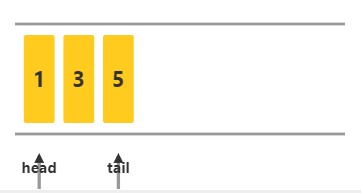
向佇列中新增1-5,直到全部佔滿
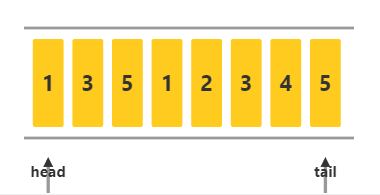
隊首1出隊
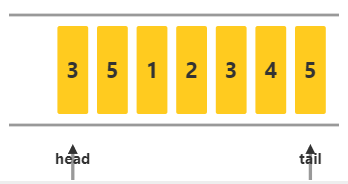
再次入隊,可以看到存取的是data[0]處的記憶體
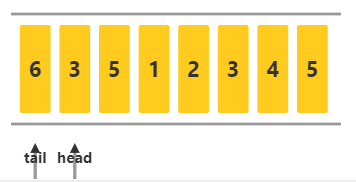
再讓隊首出隊
